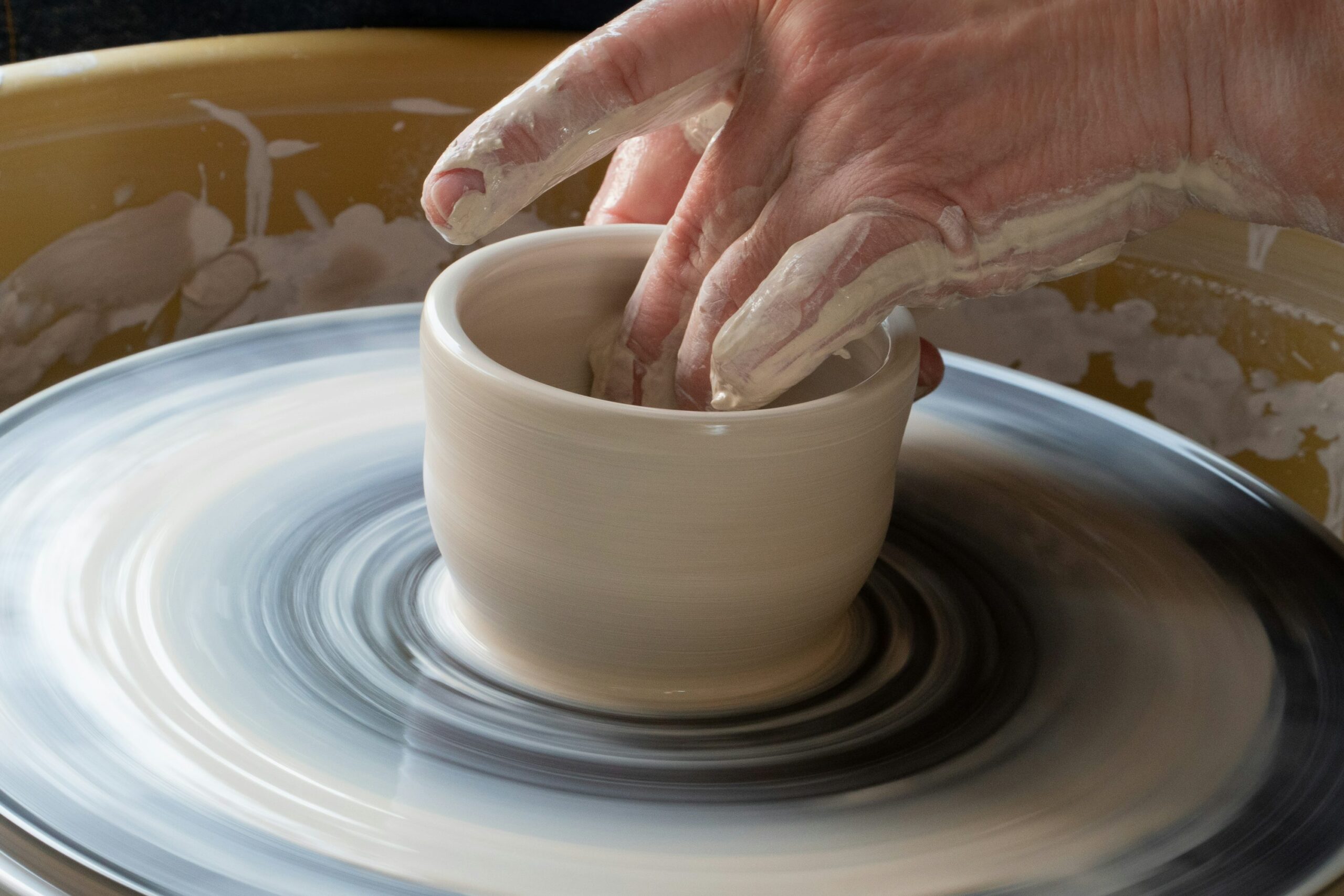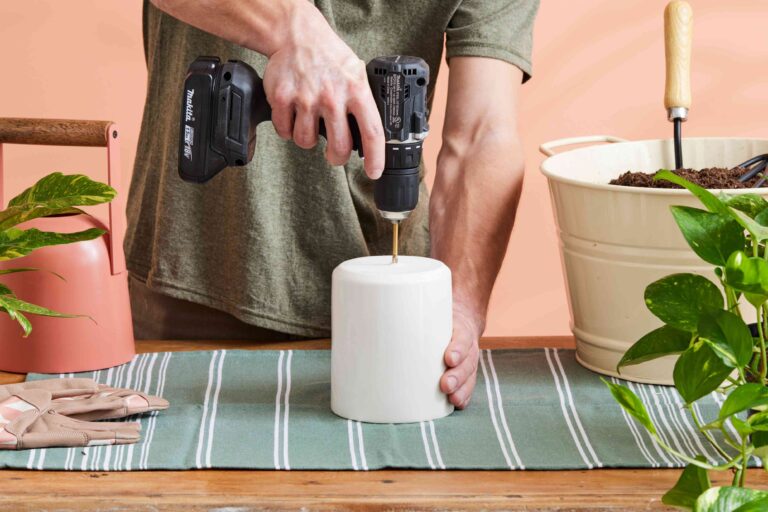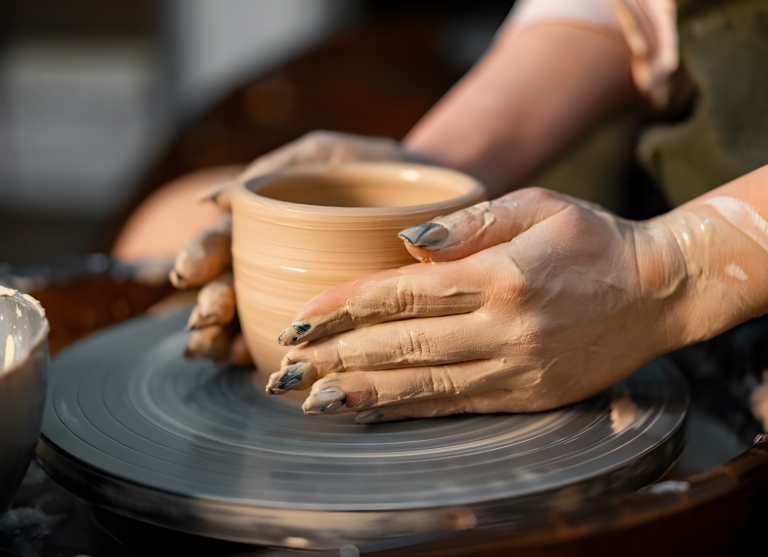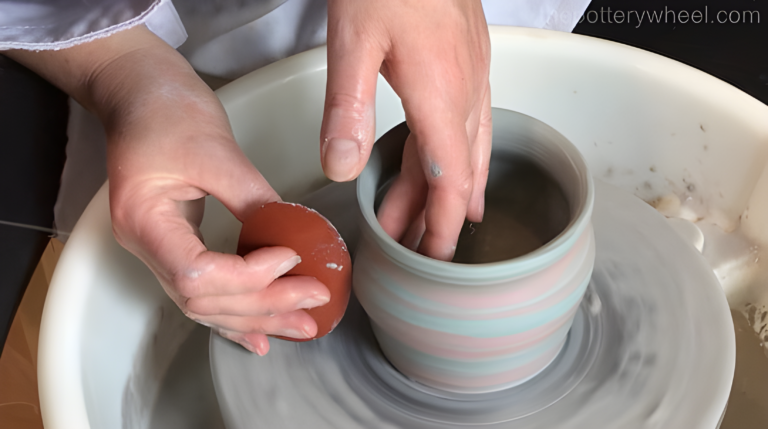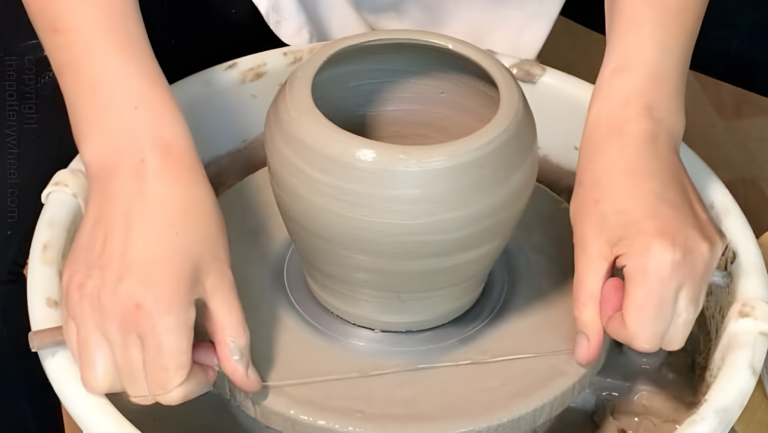How to Pick the Best Pottery Wheel
Investing in Your Creativity
Choosing a pottery wheel isn’t just about finding a machine—it's about investing in your creative journey. The right wheel can shape not only clay but also your artistic growth, skill development, and long-term enjoyment of the craft.
A pottery wheel is more than a purchase; it’s a tool that will support you through countless hours of experimentation, practice, and creation. If you’re serious about pottery, opting for a high-quality wheel with the right features can make a world of difference in your experience. A smooth, responsive wheel allows for better control, making it easier to refine your techniques and bring your artistic visions to life.
While budget-friendly wheels are a great starting point, consider whether an entry-level model will still serve you well as your skills evolve. Investing in a more durable, feature-rich wheel from the start could save you the cost and hassle of upgrading later.
Comfort also plays a big role in creativity. A wheel that suits your working style—whether it’s a portable model for flexible studio arrangements or a sturdy professional wheel with a quiet motor—can influence how often and how easily you create. If you find yourself struggling with a machine that doesn’t align with your needs, it could dampen your enthusiasm and limit your progress.
Finally, consider this: pottery is an art form that thrives on practice. A reliable, well-built wheel encourages consistency, allowing you to focus on improving your skills rather than troubleshooting mechanical issues. The better the tool, the more seamless your creative flow will be.
The Price Factor
When purchasing a pottery wheel, price is often one of the biggest deciding factors. However, the cost of a wheel isn’t just about the initial purchase—it's about the long-term value it provides.
Pottery wheels come in a wide price range, from budget-friendly beginner models to high-end professional options. While it’s tempting to choose the most affordable wheel available, it’s important to think about what you’re actually getting for your money. Lower-cost wheels often have smaller motors, lower clay capacity, and fewer features, which can limit your growth as an artist. On the other hand, investing in a high-quality wheel can mean better durability, smoother performance, and a tool that supports your skills as they advance.
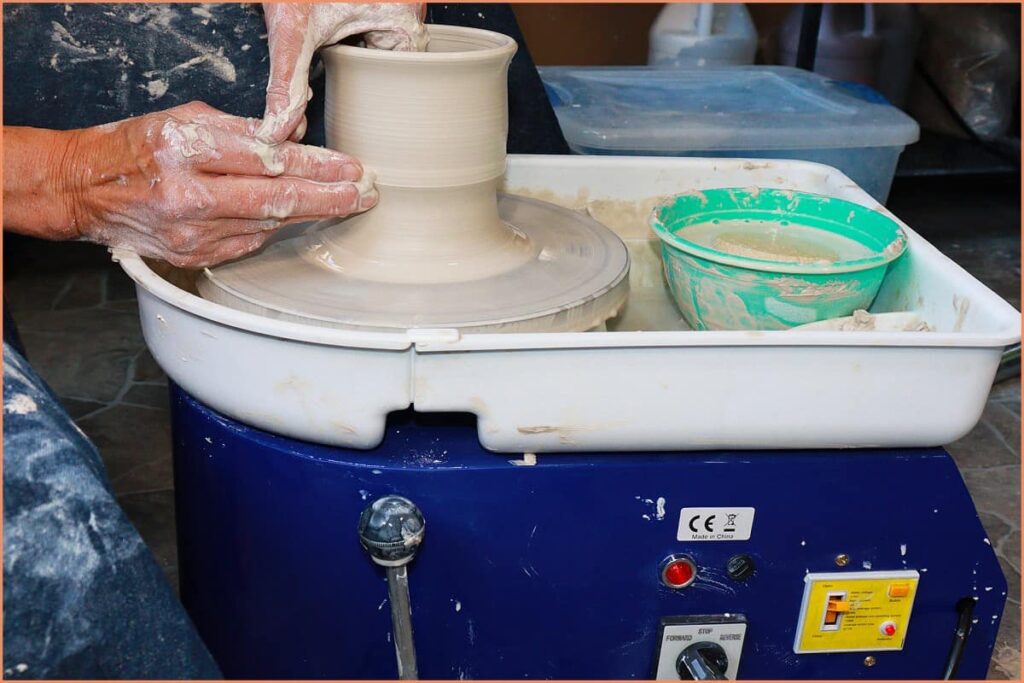
A well-made pottery wheel is a long-term investment. While a cheaper model might seem appealing at first, it may not hold up to frequent use or meet your needs as you improve.
Beyond the price of the wheel itself, consider any additional costs that might come with it. Some models require accessories like bats, stools, or splash pans, which can add to the overall expense. If the wheel is particularly heavy, factor in the cost of shipping or transportation. Maintenance is another aspect—some budget wheels may require more repairs over time, while high-end models are designed for longevity with minimal upkeep.
Ultimately, your budget should reflect your goals. If pottery is just a casual hobby, a basic wheel might be all you need. But if you’re serious about developing your craft, spending a little more upfront can save you from needing an upgrade later. Think of your pottery wheel as an investment in your creative future, not just a one-time purchase.
Durability and Long-Term Use
A pottery wheel isn’t just a short-term purchase—it's a tool that can last for years, even decades, if chosen wisely. Durability plays a key role in ensuring a smooth and consistent experience, whether you’re a beginner or a seasoned potter.
The materials and construction of a wheel determine its longevity. High-quality models are built with strong metal frames, durable motors, and wear-resistant components designed to handle frequent use. Cheaper models, while more affordable upfront, may have plastic or lightweight parts that degrade faster under constant pressure. Over time, this can lead to mechanical failures, requiring repairs or even a full replacement.
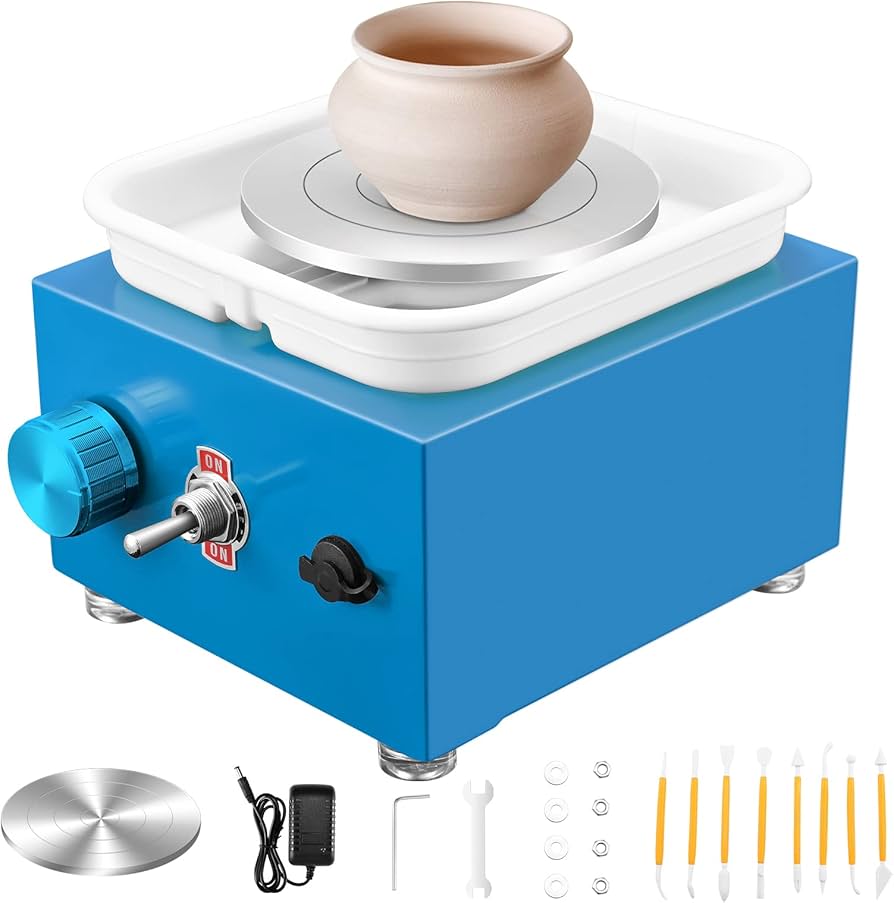
A well-built wheel is a reliable partner in your creative journey. Choosing a model known for durability means fewer technical issues and more time focused on your craft.
Motor performance is another factor to consider. An underpowered motor may struggle with heavy clay loads, leading to strain and early wear. Higher-end wheels often come with industrial-grade motors designed to sustain long hours of use without overheating or losing power. If you plan to throw large pieces or work on intensive projects, investing in a wheel with a powerful, long-lasting motor is a smart choice.
Maintenance also affects longevity. Some wheels require regular lubrication, belt replacements, or adjustments to keep them in top shape, while others are nearly maintenance-free. Kickwheels, for example, have fewer mechanical parts and can last a lifetime with minimal upkeep. Electric wheels, while more convenient, may need occasional servicing to ensure optimal performance.
Ultimately, choosing a durable pottery wheel isn’t just about avoiding repairs—it's about ensuring a consistent, enjoyable experience for years to come. Investing in a well-constructed model means less frustration, more creative freedom, and a tool that grows with you as an artist.
Portability: Do You Need to Move Your Wheel?
For some potters, a stationary pottery wheel is ideal—it stays in one spot, ready for use whenever inspiration strikes. But for others, portability is a key factor, whether due to limited space, teaching needs, or frequent studio rearrangements. Understanding how different wheels vary in terms of mobility can help you choose the right model for your lifestyle.
Lighter, compact electric wheels are the best option for portability. These models are designed to be easy to transport and store, making them popular among teachers, traveling artists, and those who work in multi-use spaces. Some portable models even come with built-in handles or foldable legs for added convenience. However, due to their smaller size, they may have lower clay capacity and less power than full-sized studio wheels.
If you need to move your pottery wheel regularly, weight matters. A compact electric wheel might weigh around 30−50 pounds, while a traditional kickwheel can be over 200 pounds.
Kickwheels, on the other hand, are the least portable option. These heavy, motorless wheels provide excellent control and durability but are nearly impossible to move without assistance. If you plan on keeping your wheel in a fixed location, a kickwheel is a great long-term choice, but it’s not practical for those who need flexibility.
Another factor to consider is space. If you have a dedicated studio, a larger, heavier wheel isn’t an issue. But if you’re working in a shared or small environment, a lightweight model that can be tucked away when not in use may be a better fit. Some wheels also come with removable parts, such as detachable splash pans or collapsible worktables, making them easier to store and transport.
Ultimately, portability depends on your personal needs. If your wheel will have a permanent home in your studio, a heavier, more stable model might be best. But if you value flexibility and need to transport your wheel frequently, choosing a lightweight, portable option will make your creative process much smoother.
Wheelhead Size and Configuration
The wheelhead is the heart of your pottery wheel—it's where your clay takes shape, making its size and design essential factors in your decision. While it may seem like a small detail, the right wheelhead can greatly impact your creative process, dictating the types of projects you can comfortably throw and how efficiently you work.
Choosing the Right Size
Wheelheads typically range from 8 to 14 inches in diameter. The best size for you depends on the type of pottery you plan to create:
- Smaller wheelheads (8−10 inches) work well for delicate pieces, such as cups, bowls, and smaller decorative objects. If you mainly throw lightweight clay projects, a compact wheelhead is a practical and efficient choice.
- Larger wheelheads (12−14 inches) are better suited for wide or heavy pieces like platters, large vases, and sculptural work. A bigger surface provides more stability when working with substantial amounts of clay.
If you plan on experimenting with different project sizes, opting for a wheel with a mid-sized wheelhead (10−12 inches) offers a good balance of versatility and support.
A larger wheelhead doesn’t necessarily mean a better wheel—think about the type of work you love to create and choose a size that complements your artistic style.
Bat Compatibility
Many potters use bats, which are detachable plates that sit on top of the wheelhead. These are especially useful for larger pieces that might be difficult to lift directly off the wheel. Before choosing a pottery wheel, consider the bat system:
- Some wheels come with pre-drilled bat pins, which allow you to easily attach and remove bats.
- Others have a smooth wheelhead, requiring bats with a suction or grip-based attachment.
- If you already own a set of bats, ensure that the new wheelhead’s pin spacing matches their configuration.
For those working with plaster bats, which help remove excess moisture from clay, a bucket-style wheelhead may be a worthwhile investment. These have a recessed design that holds plaster bats securely, making them ideal for potters who prioritize drying efficiency.
Flat vs. Recessed Wheelheads
Most pottery wheels feature flat metal wheelheads, which offer a smooth, consistent surface for throwing. However, some models include a slightly recessed or grooved design to hold bats more securely in place. If you prefer trimming directly on the wheel, a wheelhead with easily removable bat pins will allow you to work seamlessly.
When selecting your pottery wheel, don’t overlook the wheelhead—it directly affects your workflow, the types of pieces you can create, and how efficiently you can work. Whether you prefer a compact, smooth wheelhead for precision work or a larger, bat-compatible option for big projects, choosing the right configuration ensures that your pottery experience is as smooth and enjoyable as possible.
Creating the Perfect Workspace
Your pottery wheel is just one part of your creative setup—the workspace around it plays an equally important role in your overall experience. A well-planned area allows for better focus, efficiency, and comfort while working with clay. Whether you have a dedicated studio or a small corner in your home, designing a functional space tailored to your needs will make a significant difference in your pottery practice.
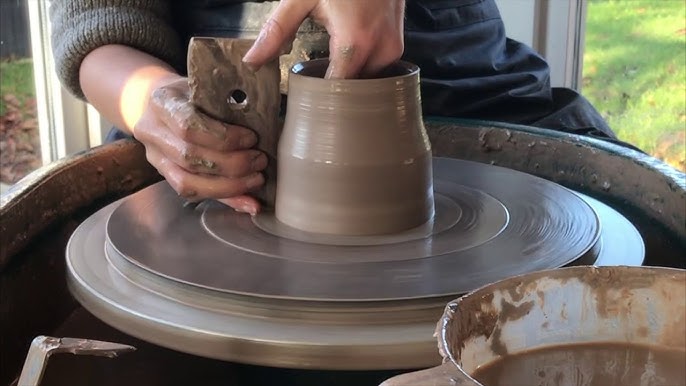
Space Considerations: Finding the Right Spot
Before setting up your pottery wheel, consider the space available and how much room you’ll need to work comfortably. Key factors include:
- Wheel Size and Clearance: Your pottery wheel should have enough space around it for you to move freely, especially when centering and throwing larger pieces. A minimum clearance of 3−4 feet around the wheel is ideal.
- Flooring: Clay and water will inevitably spill, so a surface that is easy to clean (such as tile, concrete, or vinyl) is preferable. If your space has wooden or carpeted floors, consider using a waterproof mat.
- Ventilation: Good airflow is important, especially if you work with glaze chemicals or dry clay dust. A studio with a window or an air purifier can help maintain clean air quality.
If you plan to work in a shared space, consider setting up barriers or storage units to keep your materials organized and separate from other activities.
Table and Work Surface Setup
A sturdy, easy-to-clean worktable is essential for wedging, trimming, and glazing. When selecting or positioning a table, think about:
- Height: A table that’s waist-high reduces strain on your back and arms. Adjustable-height tables or workbenches offer flexibility.
- Surface Material: Opt for sealed wood, stainless steel, or melamine-coated surfaces, which resist moisture and clay buildup.
- Storage: If space is limited, a table with built-in shelves or drawers helps keep tools, brushes, and bats within reach.
Keeping Things Clean: Splash Pans and Cleanup Strategies
Pottery is a messy art, but smart planning can make cleanup easier:
- Splash Pans: Many electric pottery wheels include removable splash pans that catch excess water and clay. These help keep your workspace clean and minimize wasted materials.
- Water Source: Having a nearby sink or water bucket makes cleaning tools and hands more convenient.
- Dust Control: Clay dust can accumulate over time, so regular wet wiping or mopping is recommended to prevent it from becoming airborne.
Clay dust can be harmful when inhaled over time. To minimize airborne particles, avoid dry sweeping—use a damp sponge or mop instead.
Lighting and Comfort
Pottery is a tactile art, but good lighting helps you see details clearly:
- Natural Light: If possible, position your workspace near a window or skylight for consistent, diffused lighting.
- Task Lighting: Adjustable LED lamps with warm white bulbs provide targeted light for detailed work.
- Seating: A comfortable, adjustable stool with lumbar support prevents strain during long throwing sessions.
Creating a well-organized, functional workspace allows you to focus on your craft without unnecessary distractions. Whether you’re working in a home studio or a professional setting, a clean, comfortable, and efficient environment enhances both productivity and creativity.
Electric vs. Kickwheel: Which Suits You Best?
Choosing between an electric pottery wheel and a kickwheel is a big decision, as it impacts your throwing experience, creative workflow, and even the longevity of your practice. Each type has its advantages and drawbacks, and the right choice depends on your artistic goals, physical comfort, and workspace setup.
The Case for Electric Pottery Wheels
Electric wheels are the go-to choice for many modern potters, from beginners to professionals. They offer precision, efficiency, and ease of use, making them ideal for production work and those who prefer a streamlined throwing process.
Advantages of Electric Wheels:
- Consistent Speed Control: The foot pedal or hand dial allows for smooth speed adjustments, making centering and shaping easier, especially for beginners.
- Less Physical Effort: Unlike kickwheels, electric models don’t require continuous foot movement, reducing strain on your legs and allowing for longer throwing sessions.
- Compact and Lightweight: Most electric wheels are smaller and easier to transport than kickwheels, making them ideal for artists with limited space or those who need portability.
- Ideal for High Production: If you plan to throw multiple pieces in one session, an electric wheel keeps up with your pace without tiring you out.
Potential Downsides:
- Requires Electricity: If you work in an area with limited power access (outdoors, off-grid studios), this may not be ideal.
- Can Be Noisy: While high-end electric wheels are quiet, some models produce a hum or mechanical noise.
- Lack of Traditional Feel: Some potters enjoy the rhythmic motion and meditative quality of a kickwheel, which electric models lack.
If you value precision, efficiency, and ease of use, an electric wheel is the best choice. However, consider a «higher-end model» if you want a quieter, smoother experience.
Why Some Potters Prefer Kickwheels
Kickwheels are manual, foot-powered pottery wheels that have been used for centuries. While they require more physical effort, they offer a unique, hands-on experience that many potters appreciate.
Advantages of Kickwheels:
- No Electricity Needed: Perfect for outdoor studios, off-grid locations, or potters who prefer a more sustainable setup.
- Extremely Durable: A well-maintained kickwheel can last a lifetime, often outlasting electric models with mechanical parts that may wear out.
- Quiet Operation: Unlike electric wheels, kickwheels are virtually silent, except for the sound of the rotating flywheel.
- Better Control and Connection: Many potters feel that a kickwheel allows for a deeper connection with the clay, as the speed is entirely controlled by their foot motion.
Potential Downsides:
- Physically Demanding: Keeping the wheel spinning requires continuous foot movement, which can be tiring over long sessions. It may not be ideal for those with knee or joint issues.
- Heavy and Hard to Move: Kickwheels can weigh 200−300 pounds, making them nearly impossible to relocate once set up.
- Slower Process: Since the speed depends on manual control, kickwheels can be less efficient for high-production pottery.
If you enjoy a traditional, hands-on approach and don’t mind the physical effort, a kickwheel offers a deeply immersive pottery experience.
Which One is Right for You?
The choice between an electric and a kickwheel comes down to your priorities as a potter:
- Need convenience, speed, and portability? → Go for an electric wheel.
- Prefer tradition, sustainability, and durability? → A kickwheel might be your best bet.
- Looking for both? Some kickwheels come with optional motorized assist features, offering the best of both worlds.
Ultimately, both options have their charm, and your decision should reflect your artistic style, workspace, and personal comfort.
Final Thoughts
Choosing the right pottery wheel is more than just a technical decision—it's an investment in your creativity, workflow, and artistic growth. Whether you opt for an electric wheel for efficiency or a kickwheel for tradition, your choice should align with your needs, space, and long-term goals as a potter.
A pottery wheel is not just about functionality—it's about finding the perfect partner for your creative journey. Choose wisely, and let the clay guide you.
A pottery wheel isn’t just a tool; it becomes an extension of your creative process. The right wheel will make throwing smoother, more enjoyable, and ultimately more rewarding. Take your time to explore different models, consider how they fit into your practice, and think about what will best support your artistry in the years to come.


